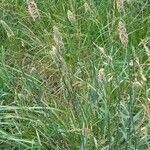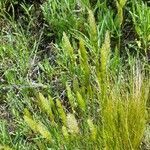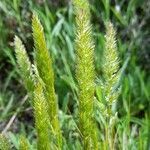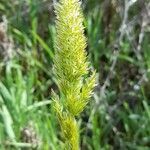Tufted annual, up to 1.5 m high. Leaf blade 50-300 x 3-12 mm; ligule an unfringed membrane. Inflorescence a narrow, cylindrical panicle, 25-170 x 6-15 mm. Spikelets 2.9-5.5 mm long, laterally compressed; glumes ± equal, much longer than spikelet, very narrowly and unevenly winged, tapering abruptly to apex, glabrous, pale green with dark green longitudinal stripes. Florets 3; lowest 2 florets reduced, sterile, 0.5-1.5 mm long, < 1/2 fertile lemma length, hairy; uppermost floret bisexual, 2.2-3.8 x 0.9-1.5 mm, hard, sparsely pubescent; anther 1.0-1.5 mm long. Flowering time Sept.-Dec.
Tufted annual to 1500 mm high. Leaf blade 50-300 x 3-12 mm. Inflorescence narrowly cylindrical, 25-170 x 6-15 mm. Spikelet 2.9-5.5 mm long; glumes glabrous, pale green with dark green longitudinal stripes, very narrowly winged, wing tapering abruptly to apex; sterile florets two, 0.5-1.5 mm long, less than 1/2 the fertile lemma length; fertile floret 2.2-3.8 x 0.9-1.5 mm, sparsely pubescent; anther 1.0-1.5 mm long.





